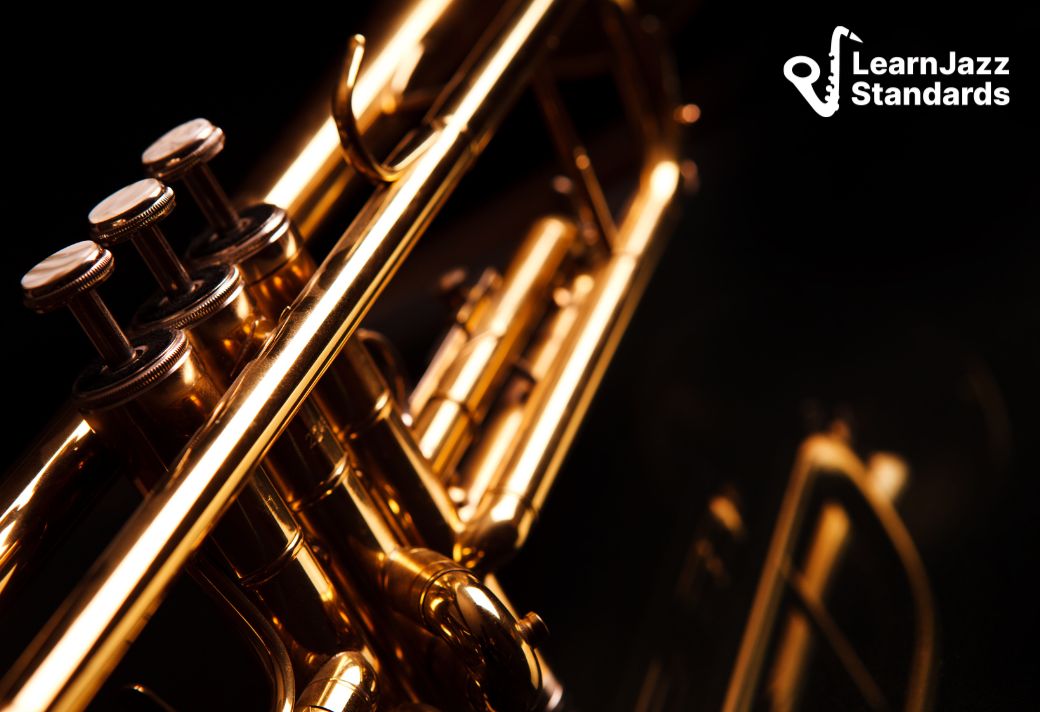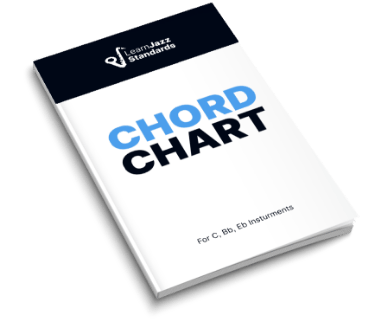Some musicians’ eyes glaze over when they hear “diminished chord,” but don’t fear! Understanding diminished chords is easy, and learning about what makes diminished chords work will make you a better jazz musician.
In this Diminished Chord Workshop, we’ll explore everything you need to know about diminished chords, from how to build them to the dominant chord secrets contained within them!
The truth is that diminished chords are actually quite simple to play on the guitar, piano, or any other instrument, so long as you know how to build them!
We’ll teach you how and when to use diminished chords to bring out the best in your jazz playing and music theory comprehension.
We’ll break down everything you need to know about diminished 7th chords, including:
- How To Build A Diminished Chord
- The Diminished Seventh Chord Formula
- Where Do Diminished Chords Come From?
- How to Play Diminished Chords on the Guitar Fretboard
Essentially, this post will help you learn, memorize, and utilize diminished triads and diminished seventh-chord shapes!
If you want to learn more about jazz theory, check out the Learn Jazz Standards Inner Circle. The Inner Circle is a membership community for musicians who share a passion for jazz and strive to become the best jazz musicians they can be.
Improve in 30 days or Less. Join the Inner Circle.
Table of Contents
How To Build A Diminished Chord
Let’s first define what a diminished chord is! Unlike a major or minor chord, which each contain both a major third and a minor third, a diminished triad consists of two minor thirds. Here is a C diminished triad on the staff and a diminished chord chart for guitar:
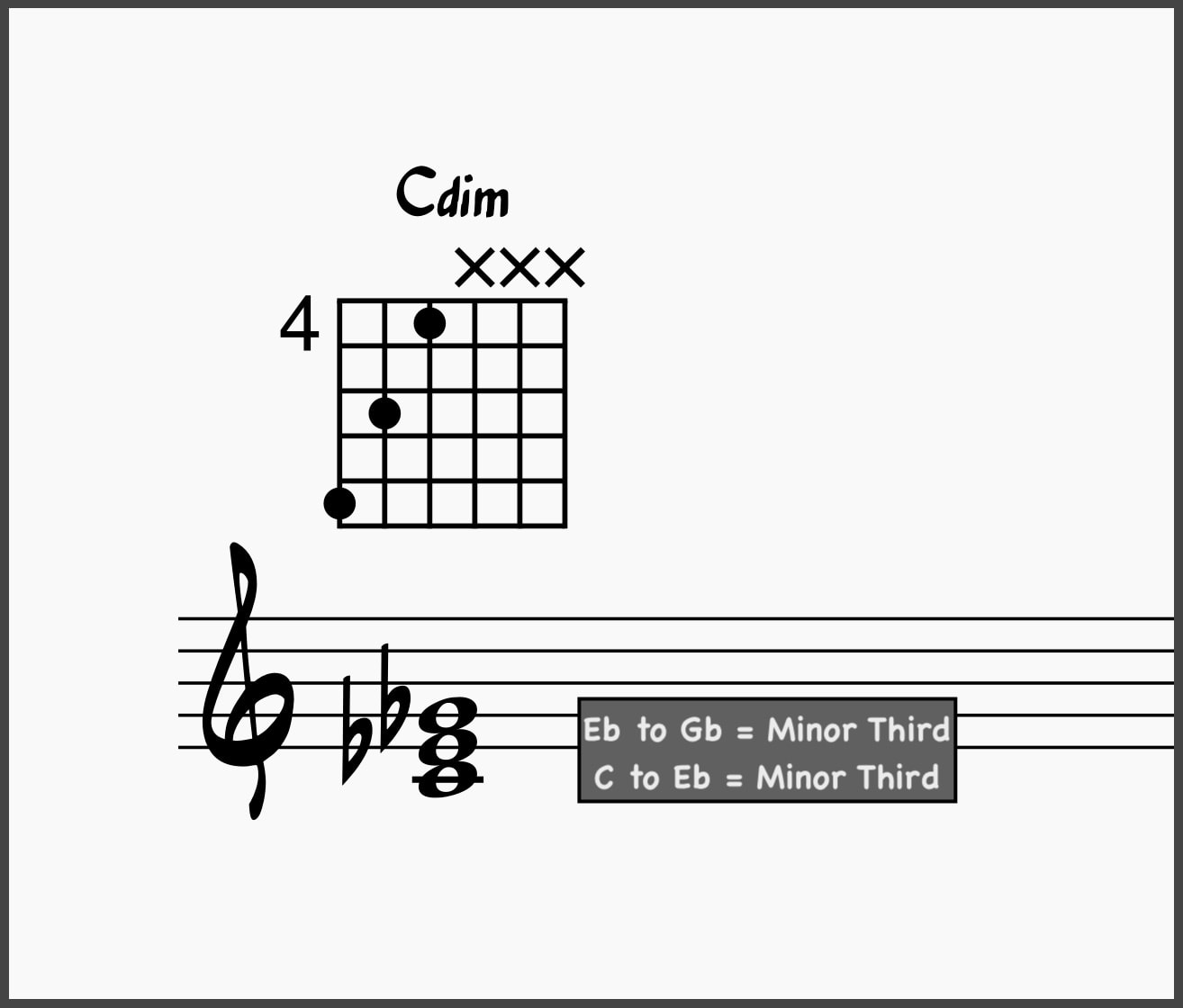
Our diminished chord consists of two stacked minor thirds:
- C to Eb = Minor Third
- Eb to Gb = Minor Third
These three notes determine the diminished quality of the chord and make it distinct from the other three chord qualities (major, minor, and augmented). Another way to think about the diminished chord is to start with a minor triad and give it a diminished fifth.
Check out the chord charts below to compare a diminished triad against a major triad, a minor triad, and an augmented triad (two major thirds). You’ll learn what sets diminished chords apart from major and minor chords.
C Diminished Chord Compared to a C Major Chord
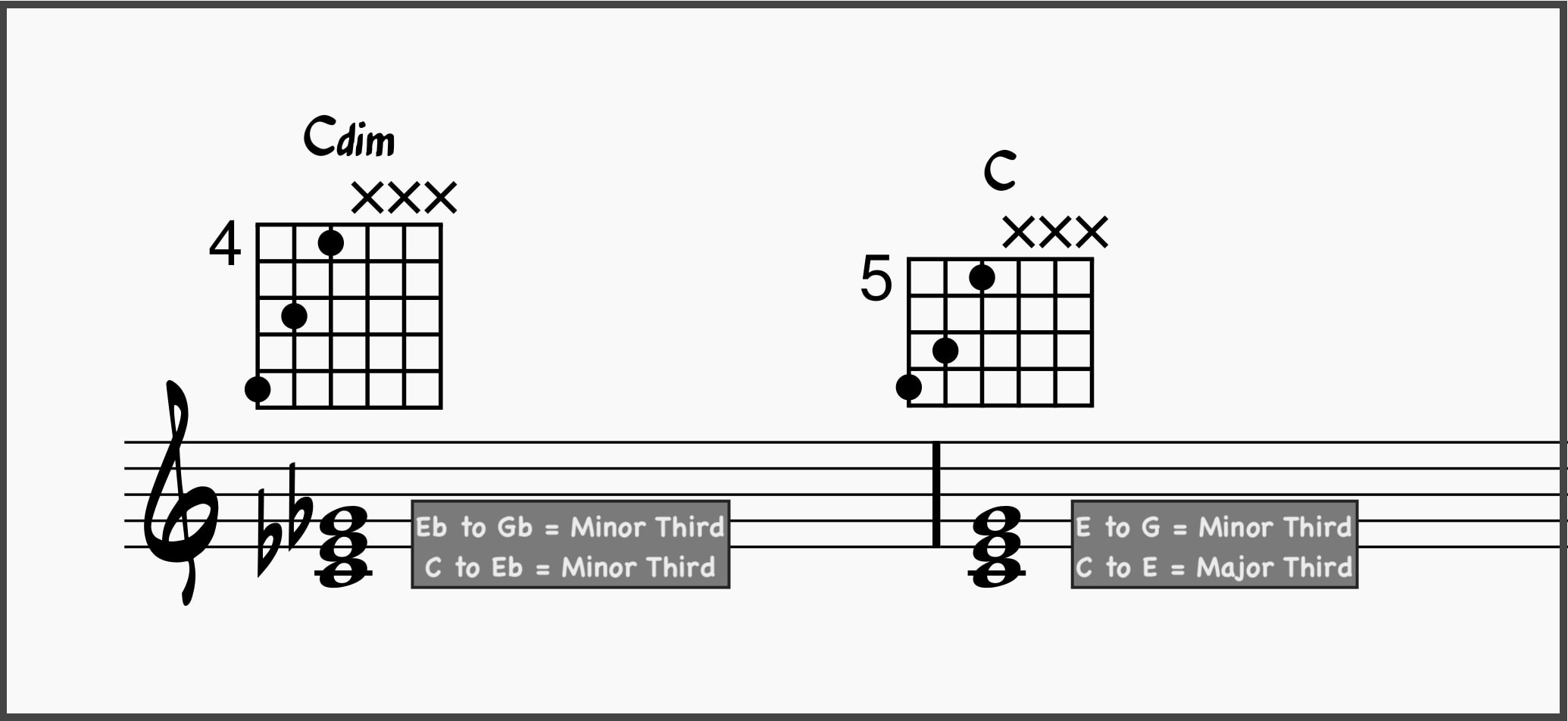
Our major chord consists of one major third and one minor third:
- C to E = Major Third
- E to G = Minor Third
- All together: C, E, G
Compare that to our diminished triad, which has two minor thirds:
- C to Eb = Minor Third
- Eb to Gb = Minor Third
- All together = C, Eb, Gb
Check out this article to learn more about major triads and how they work on the guitar.
C Diminished Chord Compared to a C Minor Chord
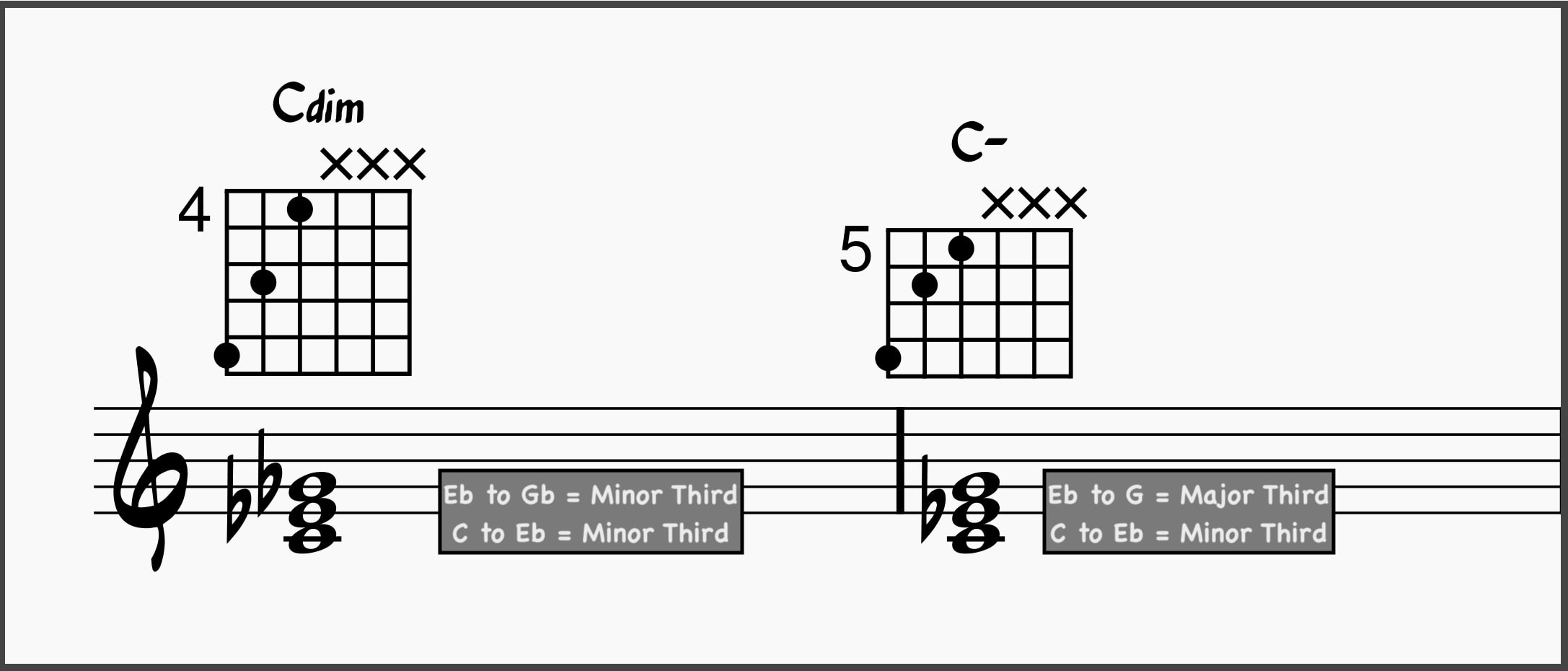
Our minor chord consists of one minor third and one major third:
- C to Eb = Minor Third
- Eb to G = Major Third
- All together: C, Eb, G
Compare that to our diminished triad, which has two minor thirds:
- C to Eb = Minor Third
- Eb to Gb = Minor Third
- All together: C, Eb, Gb
All you have to do to change a C minor chord to a C diminished chord is replace the perfect fifth with a diminished fifth. Or, replace the G natural with a G flat.
Check out this article to learn more about minor triads and how they work on the guitar.
C Diminished Chord Compared to a C Augmented Chord
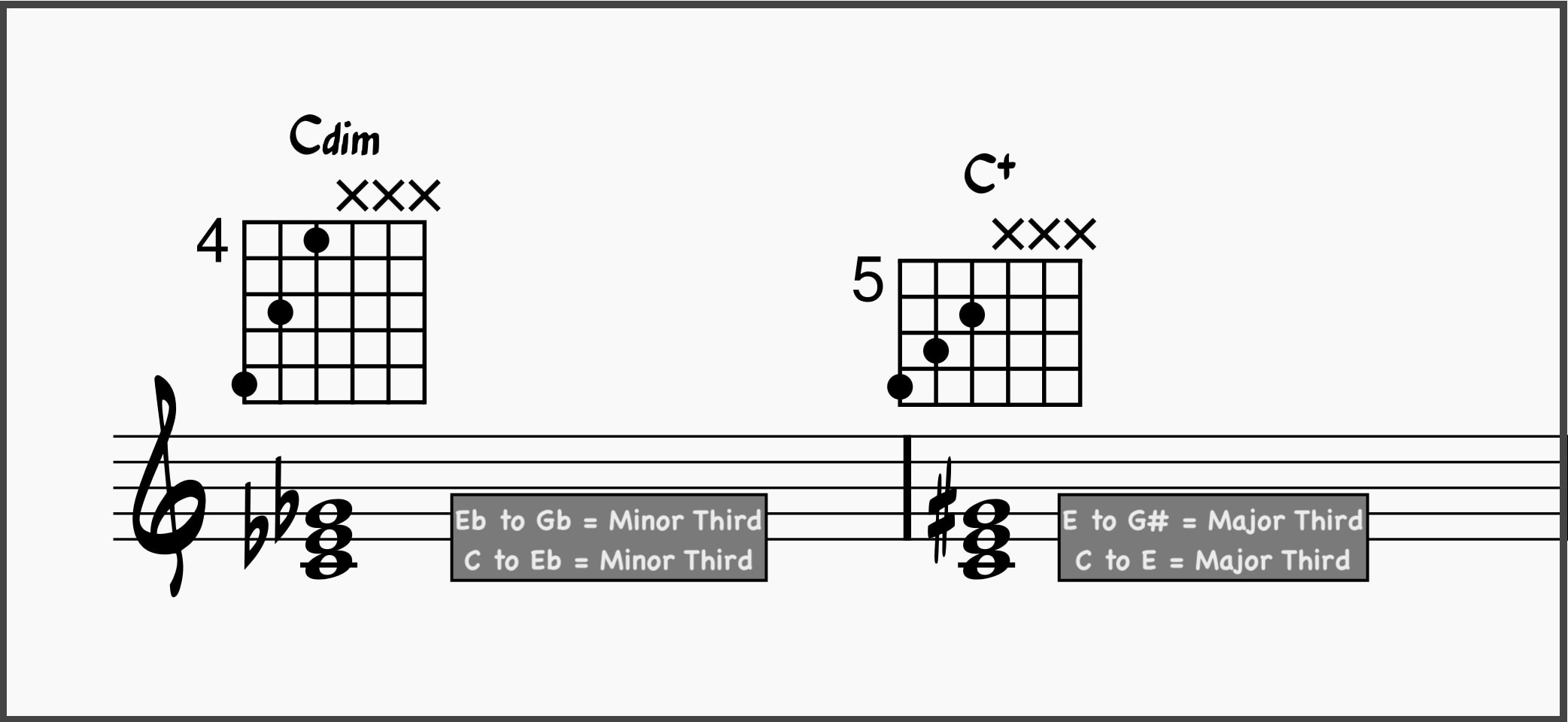
Our augmented chord is built from two major thirds:
- C to E = Major Third
- E to G# = Major Third
- All together: C, E, G#
Compare that to our diminished triad, which has two minor thirds:
- C to Eb = Minor Third
- Eb to Gb = Minor Third
- All together: C, Eb, Gb
Check out this article to learn more about augmented triads and how to play them on the guitar.
But, What About the Diminished Seventh Chord?
That’s right! So far, we’ve looked at diminished triads, which are made of three notes—a root, a third, and a fifth. However, in jazz, you are more likely to encounter diminished seventh chords, which are made of four notes—a root, a third, a fifth, and a seventh!
Diminished Seventh Chord Formula
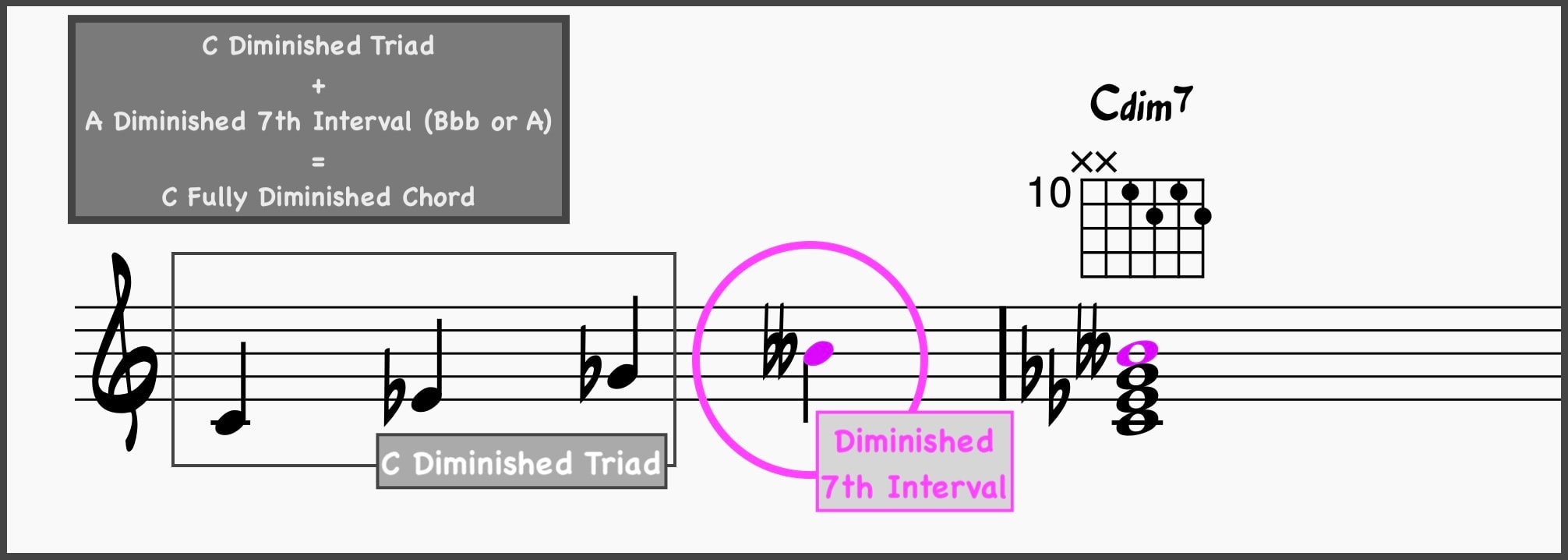
The guitar chart shows an open-position C diminished seventh chord, which differs from the voicing shown on the staff. Playing certain closed-position voicings on the guitar is sometimes impossible, depending on the notes.
Check out this article to learn more about chord voicings.
Chord Formula: Root-b3-b5-bb7
Using this chord formula, the notes in a Cdim7 would be C-Eb-Gb-Bbb(A).
Let’s take a look at what a Cdim7 looks like notated in close root position, 1st inversion, 2nd inversion, and 3rd inversion:

The first inversion of a C fully diminished chord makes an Eb fully diminished chord. The second inversion makes a Gb fully diminished seventh chord, and the third inversion creates an A diminished seventh chord (enharmonically equivalent to Bbb).
Because each note in each chord is exactly a minor third away from its adjacent notes, each inversion is symmetrical or identical to the previous one in terms of each note’s distance away from its adjacent notes. On the guitar, this means the shapes are identical. All you have to do is transpose them.
What About Half-Diminished Seventh Chords?
Half-diminished chords and fully-diminished chords both contain a diminished triad. However, the fourth note creates the key difference between Diminished 7th Chords and Half-Diminished Chords.
A half-diminished chord has a minor 7th interval in it. To make it a fully diminished 7th chord, you need to take the minor 7th interval and flatten it by one half-step to create a diminished 7th interval.
Any four-note seventh chord must have one of three different types of 7th interval:
- Major 7th: Found in any major 7th chord and in any minor chord with a major 7th (Not in any diminished chord)
- Minor 7th: Found in any dominant chord, minor 7th chord, minor 7 b5 chord (half-diminished), and other minor chord qualities (minor 6th chord, etc)
- Diminished 7th: Found only in dim7 chords
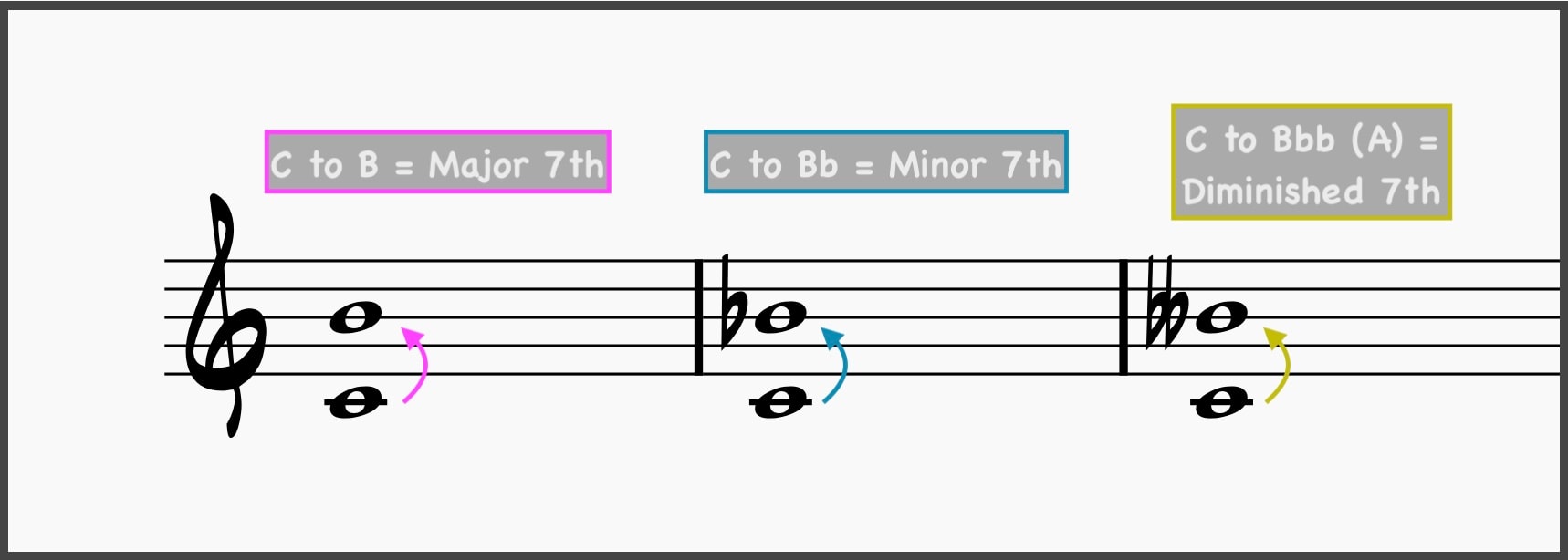
Above, you’ll find a major seventh (pink), minor seventh (blue), and diminished seventh (yellow-green) notated on the staff.
Check out this article to learn more about musical intervals like major and minor sevenths.
Half-diminished chords have a minor 7th interval, and fully diminished chords have a diminished 7th interval:
Note that the chord charts show different voicings than the notes on the staff. You’d need extremely big hands or a very small guitar to play these diminished chords in closed root position!
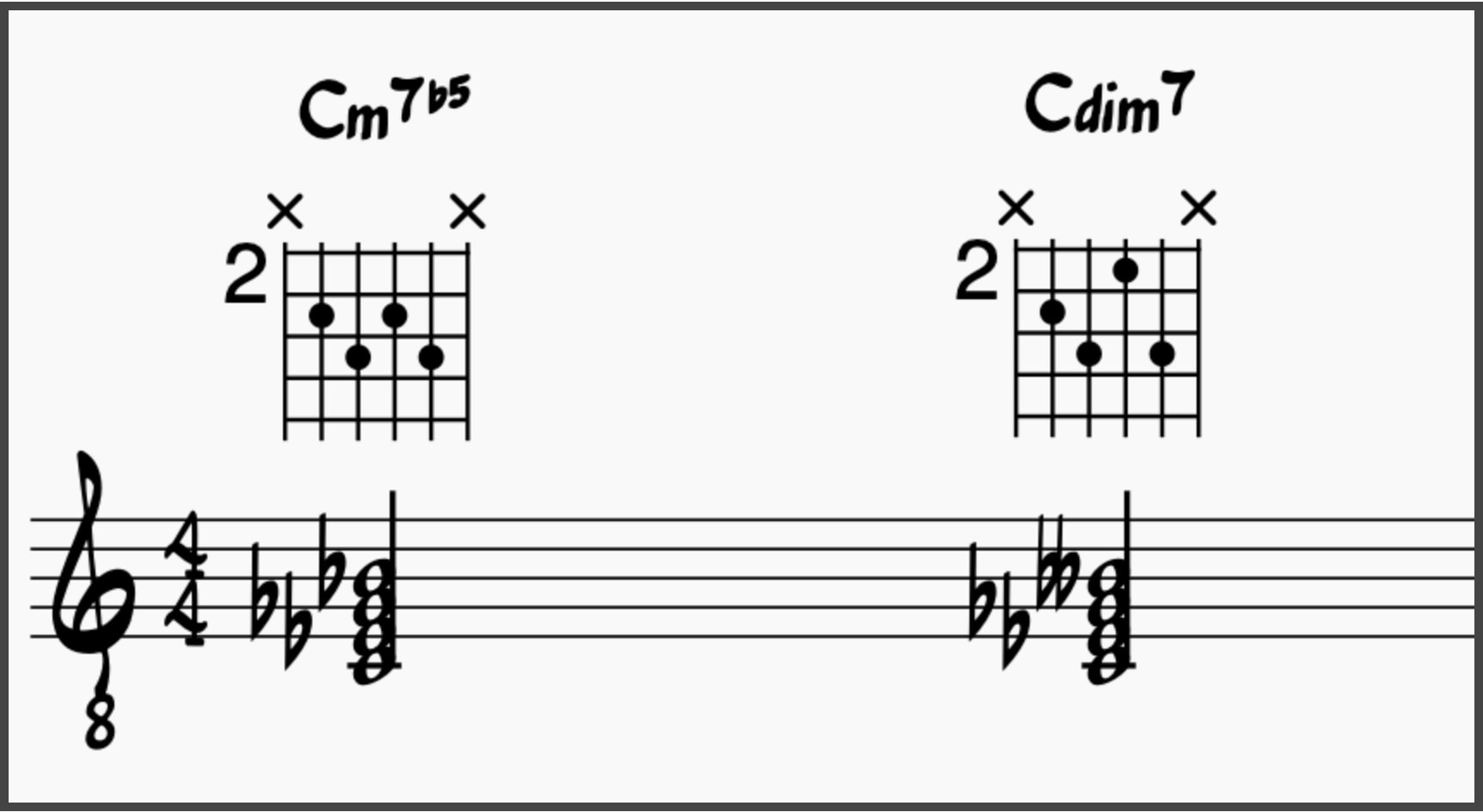
A regular Cm7b5 chord is spelled like this:
- Bb (Minor 7th)
- Gb (Flat 5th)
- Eb (Minor 3rd)
- C (Root Note)
However, a fully diminished C chord is spelled like this:
- Bbb (Enharmonically Equivalent to a Major 6th Interval or the note “A”)
- Gb (Flat 5th)
- Eb (Minor 3rd)
- C (Root Note)
Check out our article on half-diminished chords to learn more. And, if you wish to learn more about 7th chords in general, check out our ultimate guide to 7th chords.
BEFORE YOU CONTINUE...
If music theory has always seemed confusing to you and you wish someone would make it feel simple, our free guide will help you unlock jazz theory secrets.

Where Does The Diminished Chord Come From?
We now know the characteristics that make diminished chords unique from other chords, but that doesn’t answer the question, “Where do diminished chords come from?” That depends on the type of diminished chord!
Diminished triads are diatonic and are found in a variety of common scales. Half-diminished chords are also diatonic and occur in many scales. However, fully diminished seventh chords only appear in the harmonic minor scale and diminished scales.
Let’s look at examples of each.
Diminished Triads
A diminished triad occurs naturally in several scales when you harmonize them in 3rds. Here are the scales in which diminished triads occur:
- The Major Scale
- The Natural Minor Scale
- The Harmonic Minor Scale
- The Melodic Minor Scale
- Diminished scales!
See all diminished triads squared off in purple:

1. Major Scale

In the major scale, we find a diminished triad built from the seventh scale degree. This is the vii° chord, and it is a B diminished triad (B, D, F) in the key of C.
Check out this article to learn more about the major scale.
2. Minor Scale

In the minor scale, we find a diminished triad built from the second scale degree. This is the ii° chord, and it is a D diminished chord (D, F, Ab) in the key of C-.
Check out this article to learn more about the natural minor scale.
3. Harmonic Minor Scale

The harmonic minor scale is a non-diatonic scale that is nearly identical to the natural minor scale, except it has a major 7th interval instead of a minor 7th interval. The major 7th creates some interesting chords within the scale.
There are two diminished triads in the harmonic minor scale. One is found on the second scale degree and is the ii° chord. The other is found on the 7th scale degree and is the vii° chord.
Check out this post to learn more about using the harmonic minor scale.
4. Melodic Minor Scale

The melodic minor scale is another non-diatonic scale that is nearly identical to a natural minor scale, but instead has a major sixth and seventh scale degree.
When harmonizing this scale, you’ll find diminished triads on the sixth and seventh scale degrees. They are the vi° chord and vii° chord, respectively.
Check out this article to learn more about the melodic minor scale.
5. Diminished Scales

Diminished scales are symmetrical, octatonic (8-note) scales that consist of four segments, each a minor third in length, or three half steps. These segments are further divided into either a half step and a whole step, or a whole step and a half step. This determines which of the two diminished scales you are playing.
- half-whole diminished
- whole-half diminished
Their names indicate the order of the steps: a half step followed by a whole step, or a whole step followed by a half step. Regardless of which one you play, each segment equals a minor third.
When you harmonize the diminished scale, you have nothing but diminished triads! The image above shows a half-whole diminished scale.
Check out this article for more on the diminished scale.
Half-Diminished Seventh Chords
As we mentioned above, seventh chords are four-note chords. Half diminished seventh chords consist of a diminished triad with a minor seventh interval added to the top. Half diminished chords appear in the following scales:
- The Major Scale
- The Natural Minor Scale
- The Harmonic Minor Scale
- The Melodic Minor Scale
Find the half diminished seventh chords boxed off in purple below:
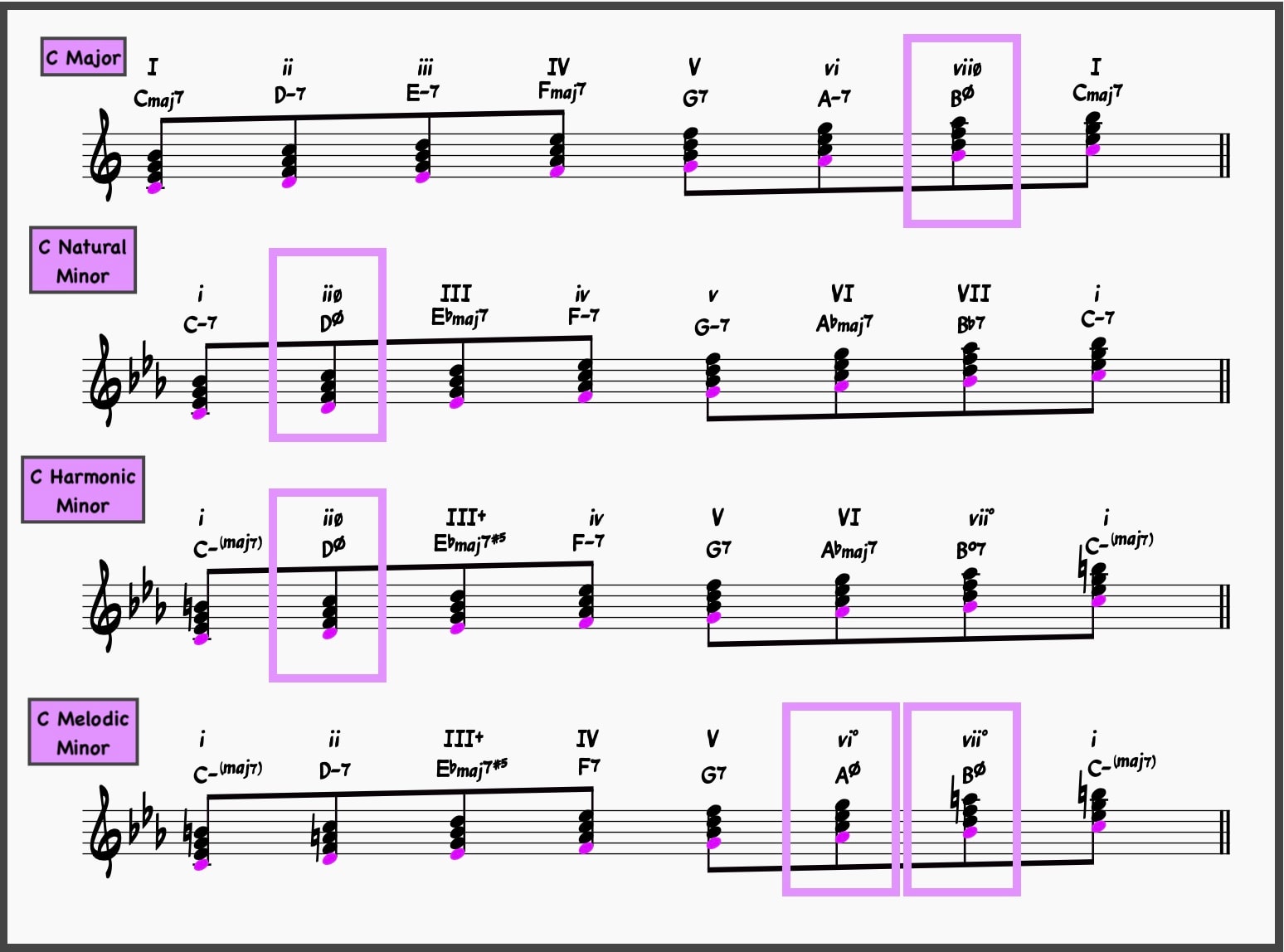
Half diminished seventh chords appear naturally on the seventh chord of the major scale and the second chord of the natural minor scale.
In harmonic minor, a half diminished chord appears on the second scale degree, while two half diminished chords appear on the sixth and seventh scale degrees of the melodic minor scale.
They do not occur in diminished scales.
Fully Diminished Seventh Chords
Fully diminished seventh chords are much rarer and only occur in diminished scales and on the 7th scale degree or the leading tone of the harmonic minor scale.

Fully Diminished Chords Demystified on the Guitar Fretboard

image source: Wikimedia Commons
Diminished chords are fairly easy to memorize on the guitar because they are symmetrical.
This means the shape of the root position is identical to the shape of all of its inversions. By memorizing one chord shape per string group, you also learn three inversions of that chord shape because they are the same shape.
Here is an explanation of how that works. A fully diminished chord is built from four minor 3rd intervals (or a diminished triad with an additional minor third added to the flat 5th).
Each note is equally distant from the other adjacent notes.
For example, in a Cdim7 chord, the C is a minor third away from the Bbb and the Eb. The Gb is a minor third away from the Eb and the Bb. And so on. If you played a diminished arpeggio—C to Eb to Gb to Bbb back to C—the path you took to get to the next C was made entirely from minor 3rd intervals.
Another way to view this is to examine how diminished chords evenly divide an octave. The twelve-tone octave can be evenly divided into four consecutive minor thirds.
This means diminished chord shapes and their inversions are crystallized into identical shapes. But the best way to understand this concept is to play it:

As you can see, we use the same chord shape, regardless of which chord inversion we are playing.
However, the shapes change depending on which string group we play on. Remember, however, that the intervallic relationships between the notes never change. Each note is always a minor third from adjacent notes.
Barring advanced diminished chord voicings that string skips, there are only three diminished chord shapes you’ll need to know to fully utilize diminished chords in chord progressions.
Let’s learn all three fully diminished chord shapes:
1. G Diminished Chords on the “EADG” String Group
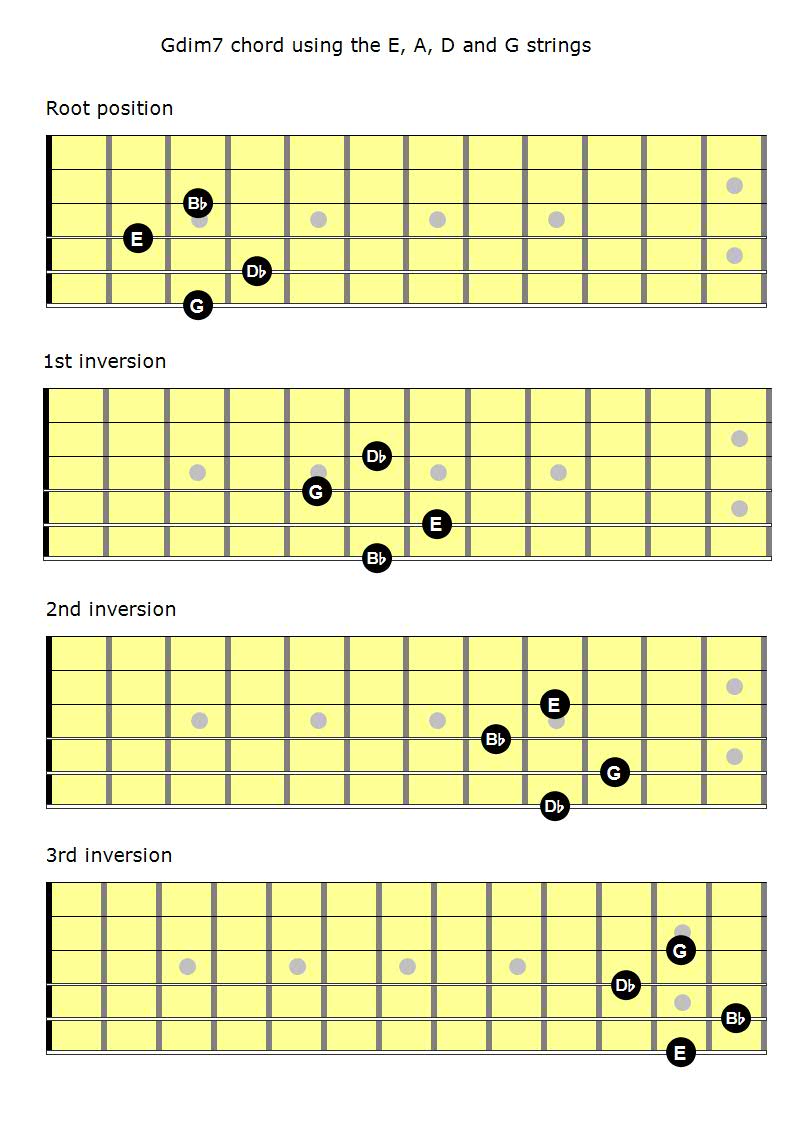
2. Diminished Chords on the “ADGB” String Group
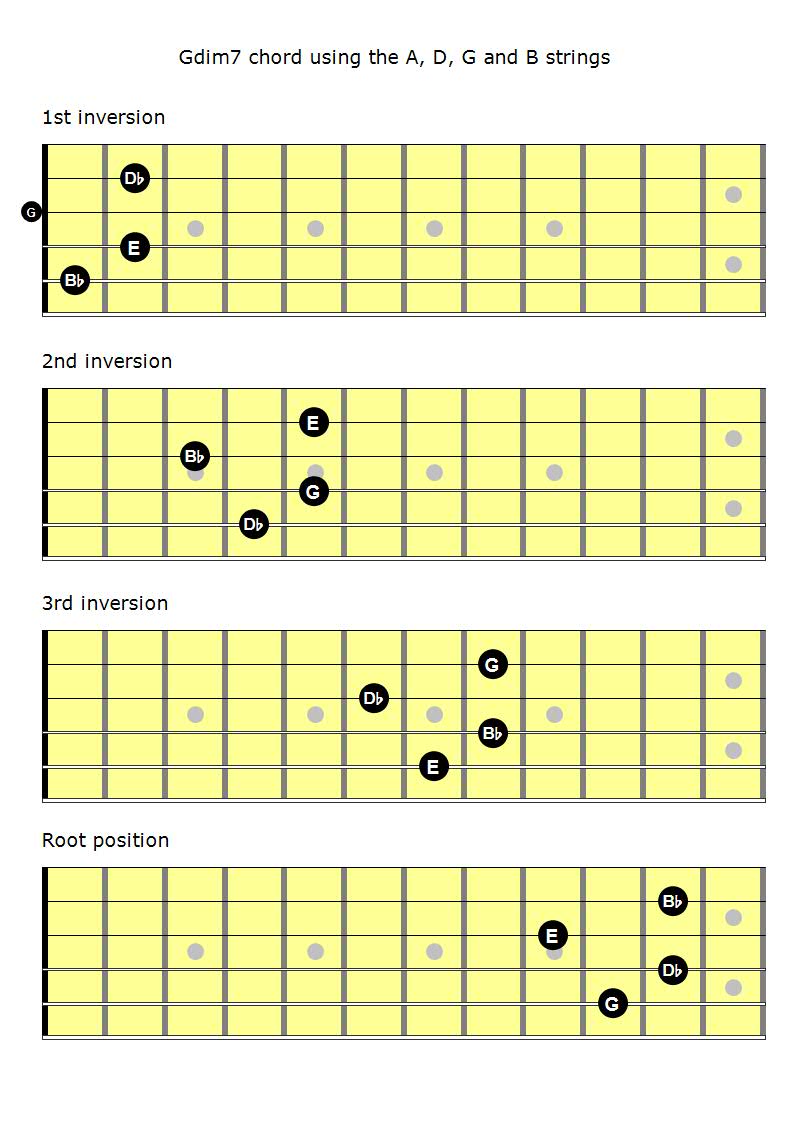
3. G Diminished Chords on the “DGBE” String Group
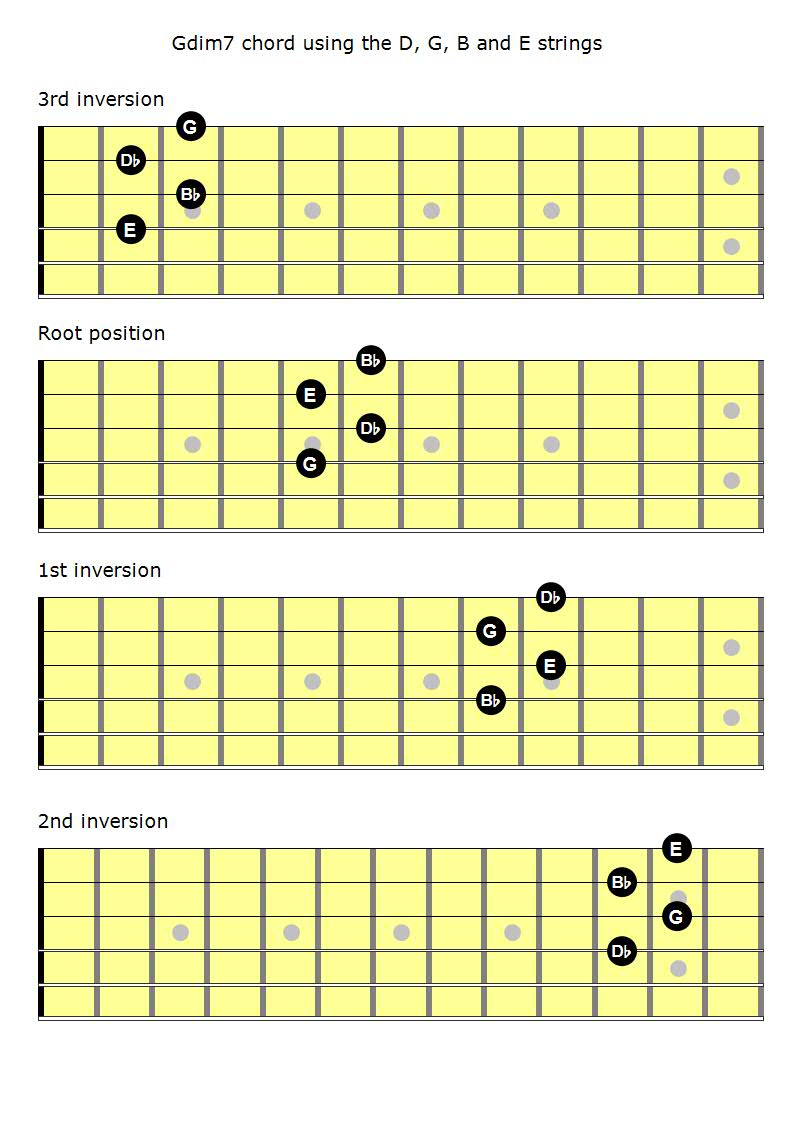
Master Diminished Chords When Improvising—Join The Learn Jazz Standards Inner Circle
If you found this article helpful and want to take your jazz playing to the next level, check out the Learn Jazz Standards Inner Circle.
The Inner Circle helps you cut out all the noise and focus on the things that make you a better musician and a stronger player.
Improve in 30 days or Less. Join the Inner Circle.



